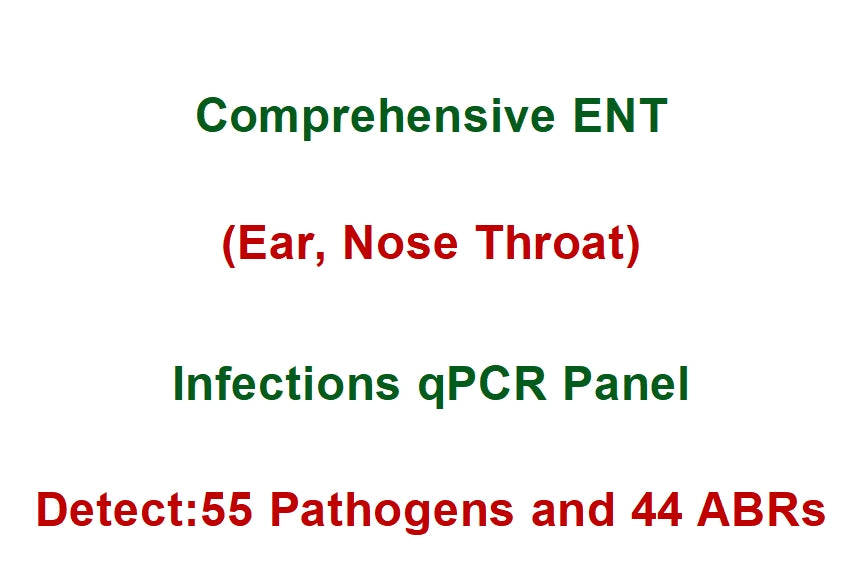Comprehensive ENT (Ear, Nose Throat) Infections qPCR Panel
Comprehensive ENT (Ear, Nose Throat) Infections qPCR Panel
无法加载取货服务可用情况
Comprehensive ENT (Ear, Nose Throat) Infections qPCR Panel
The largest Comprehensive ENT Infections qPCR Panel is an advanced molecular diagnostic assay that enables rapid and precise detection of pathogens responsible for upper respiratory tract infections. This panel is capable of identifying 32 viruses, 19 bacteria, 4 fungi, and 44 antibiotic resistance (ABR) genes—making it one of the most extensive respiratory diagnostic panels available.(55 Pathogens+44 ABR)
Designed for use in both adult and pediatric patients, the panel is well-suited for diagnosing acute and chronic otolaryngologic infections. Its speed, sensitivity, and comprehensiveness make it an invaluable tool in clinical decision-making and patient management.
Specimen Types
• Nasopharyngeal swab
• Oropharyngeal swab
• Throat swab
• Nasal swab
Otolaryngology Infections: Overview
Otolaryngology (ENT) infections affect the ear, nose, and throat. These can range from mild and self-resolving illnesses to severe infections requiring urgent intervention. Effective diagnosis and timely treatment are crucial in managing complications and preventing recurrence.
Common ENT Infections
-
Otitis Media (Middle Ear Infection): Common in children, often following viral URIs.
-
Tonsillitis: Inflammation of the tonsils caused by viral or bacterial pathogens.
-
Rhinosinusitis: Inflammation of the sinuses and nasal passages; classified as acute (<12 weeks) or chronic (≥12 weeks).
-
Streptococcal Pharyngitis (Strep Throat): A Group A Streptococcus infection requiring antibiotic therapy.
Incidence and Epidemiology
-
Global Otitis Media: 4,958.9 cases per 100,000 people in 2021; 391 million cases globally.
-
URIs: One of the most common acute illnesses; often lead to secondary ENT infections.
-
Vulnerable Populations: 20% of people experiencing homelessness have at least one ENT infection; ~50% have multiple.
Factors Influencing ENT Infection Rates
-
Age: Children under 5 are more susceptible to otitis media; adults more prone to chronic sinusitis.
-
Seasonal Patterns: Viral infections peak in winter and spring.
-
Environmental Exposure: Pollution, smoke, and allergens contribute to incidence.
-
Comorbidities: Asthma, immunodeficiencies, and cystic fibrosis elevate risk.
-
Outbreaks: Epidemics like the 2014 scarlet fever surge increased ENT-related infections.
-
Public Health Measures: COVID-19 protocols significantly reduced ENT infection rates.
Pathogens Detected
Viruses (32)
-
Adenovirus AdV_1of2
-
Adenovirus AdV_2of2
-
COVID-19 (N gene + S gene)
-
Human Bocavirus
-
Human Coronavirus 229E
-
Human Coronavirus HKU1
-
Human Coronavirus NL63
-
Human Coronavirus OC43
-
Human Enterovirus (pan assay)
-
Human Enterovirus D68
-
Human herpesvirus 3 (Varicella zoster Virus)
-
Human herpesvirus 4 (Epstein-Barr Virus)
-
Human herpesvirus 5 (Cytomegalovirus)
-
Human herpesvirus 6
-
Human Metapneumovirus (hMPV)
-
Human Parainfluenza virus 1
-
Human Parainfluenza virus 2
-
Human Parainfluenza virus 3
-
Human Parainfluenza virus 4
-
Human parechovirus
-
Respiratory Syncytial Virus A (RSVA)
-
Respiratory Syncytial Virus B (RSVB)
-
Human Rhinovirus 1/2
-
Human Rhinovirus 2/2
-
Influenza A panel
-
Influenza A/H1-2009
-
Influenza A/H3
-
Influenza B
-
Measles virus (Measles morbillivirus)
-
MERS
-
Mumps virus (Mumps rubulavirus)
-
SARS
Bacteria (19)
-
Bordetella holmesii
-
Bordetella pan assay
-
Bordetella pertussis
-
Clamydia trachomatis
-
Chlamydophila pneumoniae
-
Coxiella burnetii
-
Haemophilus influenzae
-
Klebsiella pneumoniae
-
Legionella pneumophila
-
Moraxella catarrhalis
-
Mycobacterium avium
-
Mycobacterium kansasii
-
Mycobacterium tuberculosis
-
Mycoplasma pneumoniae
-
Pseudomonas aeruginosa
-
Staphylococcus aureus
-
Streptococcus agalactiae
-
Streptococcus pneumoniae
-
Streptococcus pyogenes
Fungi (4)
-
Aspergillus niger
-
Candida albicans
-
Candida auris
-
Pneumocystis jirovecii
44 Antibiotic Resistance Genes (ABRs)
blaACC: Acinetobacter-derived cephalosporinase
blaACT: AmpC-type cephalosporinase
blaCMY: Citrobacter freundii-derived AmpC-type beta-lactamase
blaLAT: Latent AmpC-type beta-lactamase
blaFOX: Cephamycin-hydrolyzing AmpC beta-lactamase
blaGES: Guiana extended-spectrum beta-lactamase
blaMIR: Morganella morganii-inducible cephalosporinase
blaVIM: Verona integron-encoded metallo-beta-lactamase
Cfr: Chloramphenicol-florfenicol resistance methyltransferase
CMY/MOX/DHA: AmpC-type beta-lactamases (CMY, MOX, DHA families)
CTX-M_1: Cefotaximase-Munich beta-lactamase group 1
CTX-M_2: Cefotaximase-Munich beta-lactamase group 2
CTX-M_8_25: Cefotaximase-Munich beta-lactamase groups 8 and 25
CTX-M_9: Cefotaximase-Munich beta-lactamase group 9
dfrA1: Trimethoprim-resistant dihydrofolate reductase type A1
dfrA5: Trimethoprim-resistant dihydrofolate reductase type A5
ermA: Erythromycin ribosome methylation A gene
ErmB: Erythromycin ribosome methylation B gene
ErmC: Erythromycin ribosome methylation C gene
IMP-1: Imipenemase metallo-beta-lactamase type 1
IMP-2: Imipenemase metallo-beta-lactamase type 2
KPC: Klebsiella pneumoniae carbapenemase
MCR-1: Mobile colistin resistance gene 1
MecA: Methicillin resistance gene A
MecC: Methicillin resistance gene C
mefA: Macrolide efflux gene A
NDM: New Delhi metallo-beta-lactamase
OXA-48: Oxacillinase-48 carbapenemase
OXA-51: Oxacillinase-51 carbapenemase (Acinetobacter)
PER-1: Pseudomonas extended resistance beta-lactamase
qnrA: Quinolone resistance protein A
QnrB_1of4: Quinolone resistance protein B (variant 1 of 4)
QnrB_2of4: Quinolone resistance protein B (variant 2 of 4)
QnrB_3of4: Quinolone resistance protein B (variant 3 of 4)
QnrB_4of4: Quinolone resistance protein B (variant 4 of 4)
qnrS: Quinolone resistance protein S
SHV: Sulfhydryl variable beta-lactamase
Sul1: Sulfonamide resistance gene 1
Sul2: Sulfonamide resistance gene 2
Tet(M): Tetracycline resistance protein M
Tet(S): Tetracycline resistance protein S
vanA2: Vancomycin resistance gene cluster A2
vanB: Vancomycin resistance gene cluster B
VEB: Vietnamese extended-spectrum beta-lactamase
分享
files/ENT_f5d95b91-b90a-4223-95cc-0759c46ba8c6.jpg
06:35 PM


